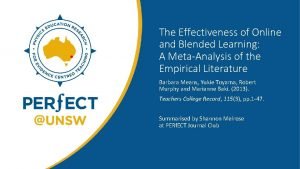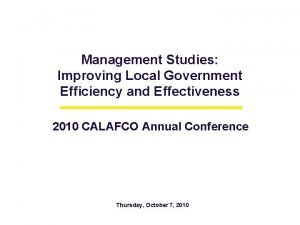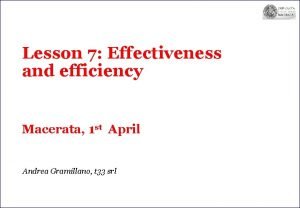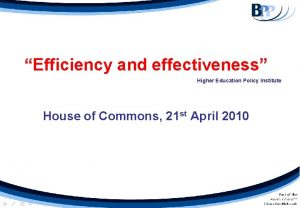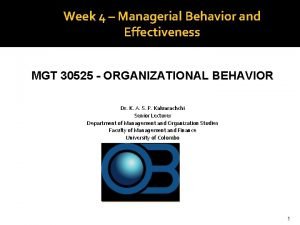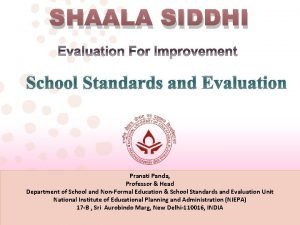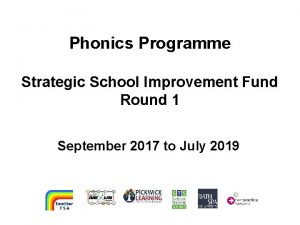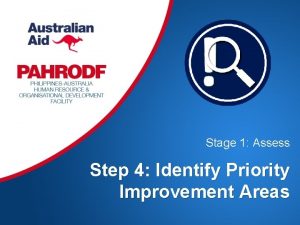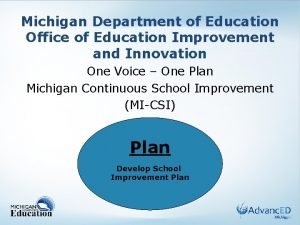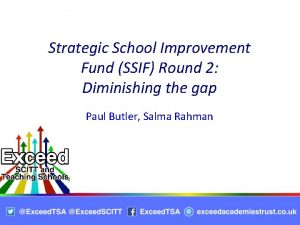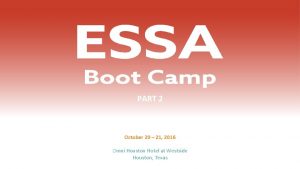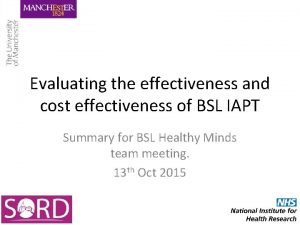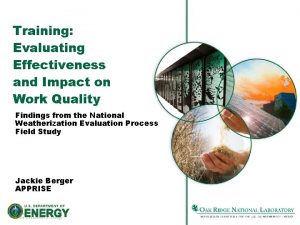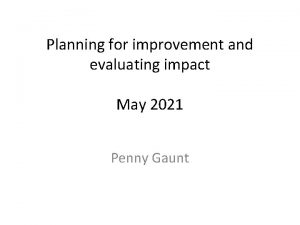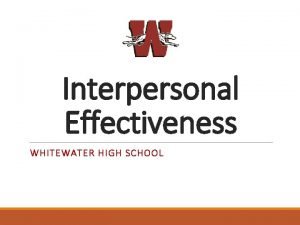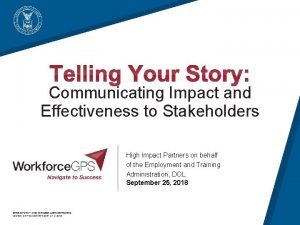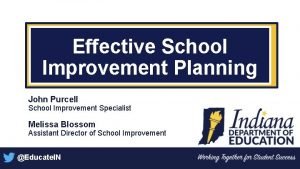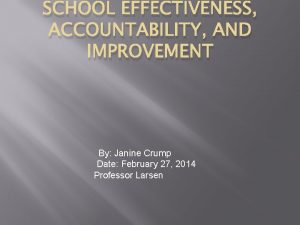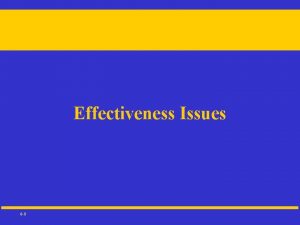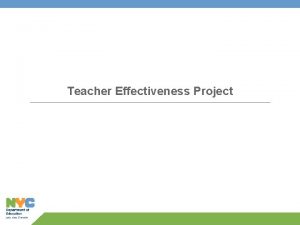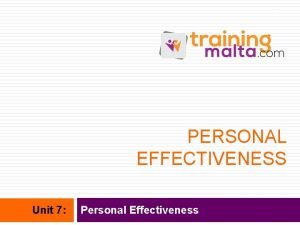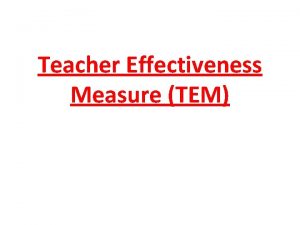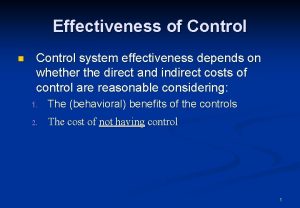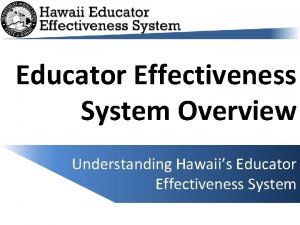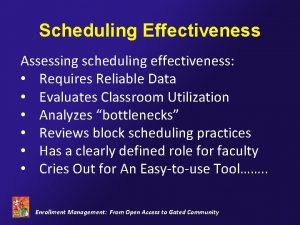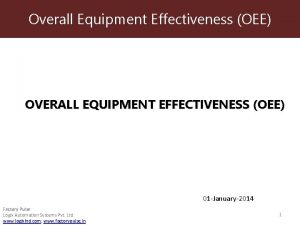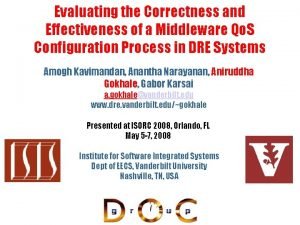Evaluating School Effectiveness and School Improvement The Impact

























































- Slides: 57

Evaluating School Effectiveness and School Improvement: The Impact of Change on School Performance Masaryk University, Brno May 9, 2010 Professor Tony Townsend Chair of Public Service, Educational Leadership and Management Department of Educational Studies, University of Glasgow

Perception Our view of the world is a product of what we are looking at, where we are standing when we are looking at it and how we feel about ourselves and the thing we are looking at. We can, however, change people’s perceptions of the world by providing them with new information, by educating them.

Drucker, 1993: p 1 Every few hundred years in western history there occurs a sharp transformation. We cross. . . a divide. Within a few short decades society rearranges itself, its world view; its basic values; its social and political structure; its arts; its key institutions. Fifty years later, there appears a new world. . . we are currently living through such a transformation.

Toffler, 1971: 12 I coined the term ‘future shock’ to describe the shattering stress and disorientation that we induce in individuals by subjecting them to too much change in too short a time.

THE PACE AND FLOW OF CHANGE

Peter Drucker People born in the 1980 s and 1990 s cannot even imagine the world into which their parents were born.

Make a list Categories of change • • • Technology Environment Health Wealth Employment Society/Population Culture Relationships Values

I think there is a world market for maybe 5 computers Thomas Watson, Chairman, IBM 1943

Popular Mechanics, 1954

Shift Happens http: //www. youtube. com/watch? v=EPI 4 x. Rszq. DA

Climate Change – Czech Republic, greenhouse gas emissions

Climate change

Prosthetics

The number of people with AIDS in Czech Republic

Comparing ourselves with others: Expenditure on health

Alleviation of Poverty

Gini Coefficient

Gini Coefficient

Percentage of population at Risk of Poverty

Income per head and life-expectancy: rich & poor countries Source: Wilkinson & Pickett, The Spirit Level (2009)

But the world is changing… Hans Rosling http: //www. ted. com/talks/hans_rosling_reveals_new_insights_ on_poverty. html

Percentage of students not performing to the standards

Start Working End Working Longevity Age 120 124 100 107 80 77 60 40 47 62 20 14 1900 18 2000 62 21 2100

Employment

Population changes

Population density

Cultural changes



After school effectiveness Thinking Globally and Acting Locally 1980 s-2010 Thinking Nationally and Acting Locally 1970 s-2000 s Before school effectiveness Thinking and Acting Locally 1870 s-1990 s 2000 BC- 1890 s Thinking and Acting Individually Townsend, 2009

Beare’s (1998) Metaphors for Education • • Prior to the 1870’s: the pre-industrial metaphor (‘for the few and the privileged’, p 5) 1870’s-1980’s: the industrial metaphor (‘bureaucracies which characterised factory production’, p 6) 1980’s-1990’s: the post industrial metaphor (‘schools are being talked of as if they are private businesses or enterprises’, p 10) 2000 s: the accountability metaphor (competition, choice and the education market).

TIMSS Gr 4 PISA Gr 8 TIMSS 15 Gr 8 15 Serbia Slovak Republic Denmark England Bahrain Estonia Bulgaria Finland Spain France Sweden Asia/M. East Armenia Gr 4 PISA Slovenia Chinese Taipei Hong Kong Germany Switzerland Greece Turkey United Kingdom Indonesia Iran Israel Japan Hungary Iceland Africa Ireland Botswana Jordan Korea Lebanon Italy Egypt Latvia Ghana Morocco Lithuania Malaysia Luxembourg Palestinian Macedonia Moldova Philippines Saudia Arabia Singapore Thailand Europe Austria Belgium Cyprus Czech Republic Liechtenstein Macao-China Tunisia South Africa The Americas Brazil Netherlands Canada Norway Chile Poland Mexico Portugal United States Romania Russian Fed. Scotland Australia Scotland New Zealand Uruguay Pacific

2009 PISA (65 countries - 95% of the world’s economy)

PISA Proficiency Levels in Science FINLAND Level 6 Level 5 Level 4 Level 3 Level 2 Level 1 Below Level 1 3% CZECH REPUBLIC 2% 10% 17% 32% 29% 14% 4% 22% 28% 23% Science Level 6 Student can consistently identify, explain and apply scientific knowledge and knowledge about science in a variety of complex life situations Science Level 1 Student has such a limited scientific knowledge that it can only be applied to a few, familiar situations 12% Below Level 1 0. 5% 4% Unable to use scientific skills in ways required by easiest PISA tasks. OECD (2007), PISA 2006 – Science Competencies for Tomorrow’s World, Table 2. 1 a

PISA 2009 Reading

PISA 2009 Mathematics

PISA 2009 Science

Maybe this will help • Classroom effectiveness – improving student achievement through learning and teaching • School effectiveness – establishing processes that focus on student learning • School improvement – the attempts by local education authorities to improve effectiveness across schools • School reform – restructuring the school system to bring about large scale change

Educational Effectiveness Research Sets out to answer the questions: • What makes a ‘good’ school? • How do we make more schools ‘good’?

Reynolds et al (2011) • looks at all the factors within schools in particular, and the educational system in general, that might affect the learning outcomes of students in their academic and social development, which means it encompasses a wide range of factors such as teaching methods, the organisation - formally and informally - of schools, the curriculum and the effects of educational ‘learning environments’ in general.

What is an effective school? • • • What criteria would you use to judge whether a school is effective or not? List five characteristics that an effective school would have that a less effective school would not Choose the two you think are the most important

Coleman et al. , 1966: 325 Schools bring little influence to bear on a child's achievement that is independent of his background and general social context. . . this very lack of an independent effect means that the inequalities imposed on children by their home, neighbourhood and peer environment are carried along to become the inequalities with which they confront adult life at the end of school. For equality of educational opportunity must imply a strong effect of schools that is independent of the child's immediate environment, and that strong independence is not present in American schools.

Rutter et al, 1979: 1 • • • do a child's experiences at school have any effect? does it matter which school he goes to? which are the features of school that matter?

Madaus et al, 1980: 22 an effective school can be defined as such. . . ‘to the extent that there is congruence between its objectives and achievements. In other words it is effective to the extent that it accomplishes what it sets out to do’

Edmonds, 1978: 3 I define an effective school as being instructionally successful for all children excepting those of certifiable physical, emotional or mental handicap. Specifically, I require that an effective school bring the children of the poor to those minimal masteries of basic school skills that now describe minimally successful pupil performances for the children of the middle class.

Rosander, 1984: 1 Effective schools are those in which all students master basic skills, seek academic excellence in all subjects, and demonstrate achievement through systematic testing. As a result of improved academic achievement, students in effective schools display improved behaviour and attendance.

Lezotte, 1989: 6 Conceptually, an effective school can be defined as one that can, in outcome terms reflective of its teaching for learning mission, demonstrate the joint presence of quality (acceptably high levels of achievement) and equity (no differences in the distribution of that achievement) among the major subsets of the student population.

Possible Goals for Effective Schools (Townsend, 1994) • • • Literacy Numeracy Other Academic Goals (eg science, history) Behaviour Attendance Self-concept Citizenship Employment Other Educational Goals (eg values, attitudes) Community Goals (eg involvement, safety)

Townsend, 1994: 37 L N OA B A SC C E OE Com Possible goals for schools

Mortimore et al, 1988: 176 The study of fifty English junior schools, sought to ‘find a way of comparing schools' effects on their pupils, while acknowledging the fact that schools do not all receive pupils of similar abilities and backgrounds’.

Banks, 1993: 2 With value-adding effectiveness. . . the distance between the most and the least advantaged remains the same. For mediating effectiveness. . . the distance between the most and the least advantaged becomes less.

Value Added and Mediating Effectiveness Value Adding Mediating

Townsend, 1994: 46 VALUE-ADDED BASIS OUTCOME BASIS Techniques for measuring effective schools

Townsend, 1994: 42 COMMUNITY INVOLVEMENT SCHOOL REVIEW AND EVALUATION REPUTATIONAL APPROACH STANDARDISED TESTING Techniques for identifying effective schools

Townsend, 1994: 47 COMMUNITY INVOLVEMENT SCHOOL REVIEW AND EVALUATION REPUTATIONAL APPROACH STANDARDISED TESTING L N OA B A SC C E OE Com Model for recognising effective schools E AD DE M U O L C A V T U O D S E

Townsend, 1994: 48 An effective school is one that develops and maintains a high quality educational programme designed to achieve both system-wide and locally identified goals. All students, regardless of their family or social background, experience both improvement across their school career and ultimate success in the achievement of those goals, based on appropriate external and school-based measuring techniques.

More information If you would like more details contact Tony Townsend: School of Education University of Glasgow Phone: +44(0)141 330 4434 Fax: +44(0)141 330 5451 email: tony. townsend@glasgow. ac. uk
 The effectiveness of online and blended learning
The effectiveness of online and blended learning Arrangement of people in an organization
Arrangement of people in an organization Efficiency and effectiveness examples
Efficiency and effectiveness examples Efficiency and effectiveness examples
Efficiency and effectiveness examples Efficiency and effectiveness in higher education
Efficiency and effectiveness in higher education Strategic profitability analysis
Strategic profitability analysis Managerial behavior and effectiveness
Managerial behavior and effectiveness Performance in key subjects (annual)
Performance in key subjects (annual) School improvement plan sample deped
School improvement plan sample deped Strategic school improvement fund round 3
Strategic school improvement fund round 3 Identifying priority improvement areas
Identifying priority improvement areas School improvement plan michigan
School improvement plan michigan Strategic school improvement fund round 3
Strategic school improvement fund round 3 School improvement plan
School improvement plan Swot analysis of school
Swot analysis of school Ambition school leadership
Ambition school leadership Hát kết hợp bộ gõ cơ thể
Hát kết hợp bộ gõ cơ thể Ng-html
Ng-html Bổ thể
Bổ thể Tỉ lệ cơ thể trẻ em
Tỉ lệ cơ thể trẻ em Chó sói
Chó sói Glasgow thang điểm
Glasgow thang điểm Chúa yêu trần thế
Chúa yêu trần thế Các môn thể thao bắt đầu bằng tiếng chạy
Các môn thể thao bắt đầu bằng tiếng chạy Thế nào là hệ số cao nhất
Thế nào là hệ số cao nhất Các châu lục và đại dương trên thế giới
Các châu lục và đại dương trên thế giới Công của trọng lực
Công của trọng lực Trời xanh đây là của chúng ta thể thơ
Trời xanh đây là của chúng ta thể thơ Mật thư anh em như thể tay chân
Mật thư anh em như thể tay chân Làm thế nào để 102-1=99
Làm thế nào để 102-1=99 Phản ứng thế ankan
Phản ứng thế ankan Các châu lục và đại dương trên thế giới
Các châu lục và đại dương trên thế giới Thể thơ truyền thống
Thể thơ truyền thống Quá trình desamine hóa có thể tạo ra
Quá trình desamine hóa có thể tạo ra Một số thể thơ truyền thống
Một số thể thơ truyền thống Cái miệng nó xinh thế
Cái miệng nó xinh thế Vẽ hình chiếu vuông góc của vật thể sau
Vẽ hình chiếu vuông góc của vật thể sau Nguyên nhân của sự mỏi cơ sinh 8
Nguyên nhân của sự mỏi cơ sinh 8 đặc điểm cơ thể của người tối cổ
đặc điểm cơ thể của người tối cổ Thứ tự các dấu thăng giáng ở hóa biểu
Thứ tự các dấu thăng giáng ở hóa biểu Vẽ hình chiếu đứng bằng cạnh của vật thể
Vẽ hình chiếu đứng bằng cạnh của vật thể Phối cảnh
Phối cảnh Thẻ vin
Thẻ vin đại từ thay thế
đại từ thay thế điện thế nghỉ
điện thế nghỉ Tư thế ngồi viết
Tư thế ngồi viết Diễn thế sinh thái là
Diễn thế sinh thái là Các loại đột biến cấu trúc nhiễm sắc thể
Các loại đột biến cấu trúc nhiễm sắc thể Bảng số nguyên tố lớn hơn 1000
Bảng số nguyên tố lớn hơn 1000 Tư thế ngồi viết
Tư thế ngồi viết Lời thề hippocrates
Lời thề hippocrates Thiếu nhi thế giới liên hoan
Thiếu nhi thế giới liên hoan ưu thế lai là gì
ưu thế lai là gì Hổ đẻ mỗi lứa mấy con
Hổ đẻ mỗi lứa mấy con Khi nào hổ con có thể sống độc lập
Khi nào hổ con có thể sống độc lập Hệ hô hấp
Hệ hô hấp Từ ngữ thể hiện lòng nhân hậu
Từ ngữ thể hiện lòng nhân hậu Thế nào là mạng điện lắp đặt kiểu nổi
Thế nào là mạng điện lắp đặt kiểu nổi
